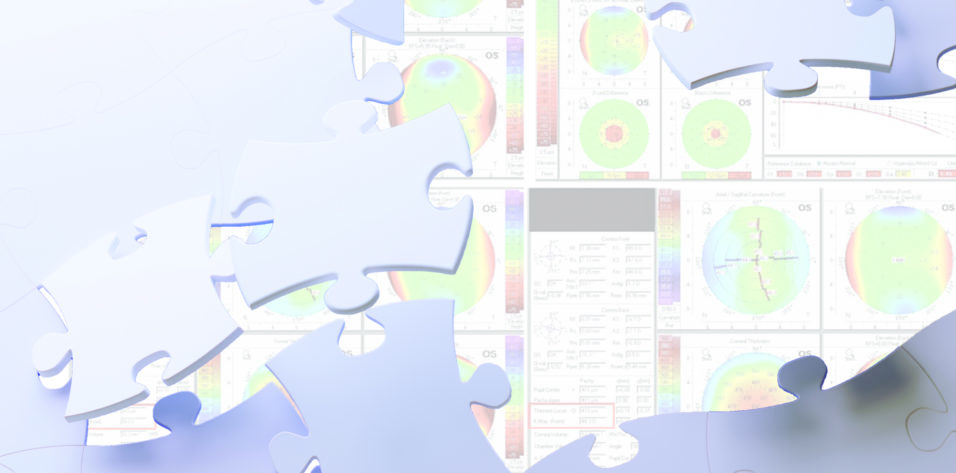

Keratoconus is a bilateral corneal ectasia that results in progressive corneal thinning and irregular astigmatism. Patients often complain of decreased vision, blur, and photosensitivity.1 The slit-lamp examination is typically normal early in the disease course. At more advanced stages, however, the slit-lamp examination may reveal corneal thinning, corneal scarring, Vogt striae, and iron lines. Corneal imaging (topography or tomography) is the most important test to identify keratoconus, which can present with different patterns of irregular astigmatism. Patients with advanced disease can lose BCVA and may benefit from wearing specialty contact lenses, including scleral, hybrid, and rigid gas permeable designs.
Treatments for keratoconus include CXL to strengthen the cornea and prevent progression and the placement of intrastromal corneal ring segments to reshape the cornea. Patients with advanced disease whose vision loss cannot be corrected with specialty contact lenses and those who cannot wear these lenses may require penetrating keratoplasty or deep anterior lamellar keratoplasty.
Individuals with keratoconus are at a higher risk of developing cataracts—and often at a younger age—than the general population.2 Surgical planning for cataract extraction is therefore essential to successful visual rehabilitation. Unfortunately, IOL selection can be challenging in this population. Keratoconus inherently affects the cornea and keratometry (K) values, which ultimately affects the reliability of IOL power calculations.
SOURCES OF INACCURACY
The inaccuracy of biometry in patients with keratoconus arises from several factors. First, the high cylinder, irregular astigmatism, and decentered cone can make K values unreliable. Second, it is more difficult to estimate the effective lens position in these eyes.3
Refractive surprises after cataract surgery are not uncommon when K values (hyperopic surprise) or total refractive corneal power (myopic surprise) is used for the IOL power calculation. In a Japanese multicenter study, a hyperopic surprise occurred in keratoconic eyes when K values were used, and a myopic surprise occurred when total corneal refractive power was used.4
IOL CALCULATION FORMULAS
Which IOL formula is the most accurate for patients with keratoconus has been a subject of great controversy. The most recent practice patterns suggest tailoring the choice of IOL formula according to disease severity (see Keratoconus Staging).
Keratoconus Staging1
Keratoconus staging has been controversial but can be stratified as follows:
Mild Maximum keratometry (K) value < 48.00 D
Moderate Maximum K value between 48.00 and 52.00 D
Severe Maximum K value > 52.00 D
1. Yazji A, Ahmad AF, Cheung N. Cataract surgery in the setting of keratoconus. American Academy of Ophthalmology EyeWiki. Accessed March 1, 2022. https://eyewiki.org/Surgical_Approach_to_Cataract_Surgery_with_Keratoconus
According to one review article, the SRK II formula may be the most accurate option in patients with mild keratoconus. No consensus was reached for patients with moderate to severe disease in this study.5
Savini et al compared the refractive accuracy of the Barrett Universal II (BUII), Haigis, Hoffer Q, Holladay I, and SRK/T formulas in 41 keratoconic eyes of individuals of Italian descent.6 The investigators concluded that the SRK/T formula was the most accurate. In a subanalysis, this formula was most accurate when patients had mild keratoconus, and it became progressively less accurate as keratoconus severity increased.
Wang et al compared the refractive accuracy of the BUII, Hoffer Q, SRK/T, Haigis, Holladay I, and Holladay II formulas in 73 keratoconic eyes.7 The study population had an average axial length of 24.93 mm, an average anterior chamber depth of 3.58 mm, and a mean age of 65 years. All of these are typical parameters for routine cataract surgery. The lowest median absolute error and the highest percentage of eyes within ±0.50 D of refractive target were achieved with the BUII formula when keratoconus was mild to moderate. Refractive accuracy was greatest with the Haigis formula when keratoconus was severe.
Watson et al found that significant overcorrections occurred when the SRK-T formula was used in eyes with very steep corneas (K value > 55.00 D).8 The investigators suggested that this was because the SRK-T formula is based on a model eye. When the cornea was steep, the model eye differed significantly from the patient’s actual anatomic measurements. The investigators stated that, for eyes with a corneal power greater than 55.00 D, using K values of 43.25 D with a mean target refraction of -1.80 D resulted in less refractive error compared to using measured K values.
In general, we believe that, compared to a hyperopic outcome, a myopic target is better tolerated by patients with keratoconus. A myopic target also promotes easier contact lens fitting.
ASTIGMATISM CORRECTION
Individuals with keratoconus have irregular astigmatism, but they may benefit from the implantation of a toric IOL to reduce or eliminate their refractive astigmatism. A toric IOL is best suited to patients with both mild keratoconus and irregular astigmatism whose visual acuity improves with manifest refraction.9
It is imperative that topography measurements and the manifest refraction correlate for a toric IOL to be implanted. We generally reserve these IOLs for patients who had acceptable vision in spectacles before their cataract developed. Topography or tomography should also have a regular appearance centrally.
Toric lenses should be avoided in patients who depend on rigid gas permeable or scleral contact lenses for satisfactory vision. If patients are motivated to get out of their contact lenses, then an appropriate contact lens holiday should be instituted, and corneal measurements should be stable before a surgical plan is developed. Generally, lens wear should be discontinued for 3 days for soft contact lenses, 2 weeks for soft toric contact lenses, and 3 weeks plus 1 week per decade of wear for rigid contact lenses.10 We recommend obtaining at least two sets of reliable measurements to help ensure true corneal stability out of contact lenses.
CONCLUSION
Patients should be counseled that prior corneal scarring from keratoconus may limit their visual potential after cataract surgery and that visual rehabilitation with contact lenses or keratoplasty may be required. A thorough discussion of refractive surprises and a possible need for further intervention should also be discussed.
1. Yazji A, Ahmad AF, Cheung N. Cataract surgery in the setting of keratoconus. American Academy of Ophthalmology EyeWiki. Accessed March 1, 2022. https://eyewiki.org/Surgical_Approach_to_Cataract_Surgery_with_Keratoconus
2. Ghiasian L, Abolfathzadeh N, Manafi N, Hadavandkhani A. Intraocular lens power calculation in keratoconus; a review of literature. J Curr Ophthalmol. 2019;31(2):127-134.
3. Smith RG, Knezevic A, Garg S. Intraocular lens calculations in patients with keratoectatic disorders. Curr Opin Ophthalmol. 2020;31(4):284-287.
4. Vastardis I, Sagri D, Fili S, Wölfelschneider P, Kohlhaas M. Current trends in modern visual intraocular lens enhancement surgery in stable keratoconus: a synopsis of do’s, don’ts and pitfalls. Ophthalmol Ther. 2019;8(suppl 1):33-47.
5. Ghiasian L, Abolfathzadeh N, Manafi N, Hadavandkhani A. Intraocular lens power calculation in keratoconus: a review of literature. J Curr Ophthalmol. 2019;31(2):127-134.
6. Savini G, Abbate R, Hoffer KJ, et al. Intraocular lens power calculation in eyes with keratoconus. J Cataract Refract Surg. 2019;45(5):576-581.
7. Wang KM, Jun AS, Ladas JG, Siddiqui AA, Woreta F, Srikumaran D. Accuracy of intraocular lens formulas in eyes with keratoconus. Am J Ophthalmol. 2020;212:26-33.
8. Watson MP, Anand S, Bhogal M, et al. Cataract surgery outcome in eyes with keratoconus. Br J Ophthalmol. 2014;98(3):361-364.
9. Moshirfar M, Walker BD, Birdsong OC. Cataract surgery in eyes with keratoconus: a review of the current literature. Curr Opin Ophthalmol. 2018;29(1):75-80.
10. Hamill MB, Ambrosio R, Berdy GJ, et al. Section 13: Refractive Surgery. 2018-2019 BCSC (Basic and Clinical Science Course). American Academy of Ophthalmology; 2018.




